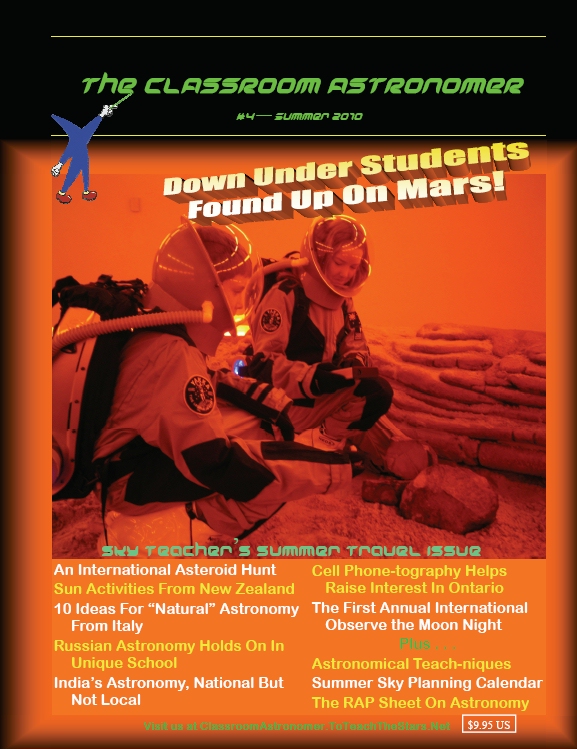|
Issue 4 - Summer 2010 Downloadable
Resources

Worlds Near Collision -
An International Asteroid Hunt
Astronomy Education
under the Southern Cross
Cell Phone-tography
Helps Raise Astronomy Interest in Ontario
Russian Astronomy Holds On In a Unique
School
Astronomy in India,
National But Not Local
Ten Ideas for 'Natural'
Astronomy from Italy
- Astronomical Teachniques -
- How High Is The Sun?
- Earth Turns from West to East
- International Observe the Moon Night
- Sky Planning Calendar
- The RAP Sheet - Research Abstracts for
Practitioners -
- Justifying Alternative Models in Learning Astronomy: A study of K-8 science
teachers' understanding of frames of reference
- Meta-analysis of Planetarium Efficacy Research
- My Views of the Classroom Universe - The
International World of Astronomy
|
|
Issue 3 - Spring 2010 Downloadable
Resources
Galileoscopes - A Photo
Story
Eratosthenes Footprints
- Shadows on a Globe
Jigsawing the
Universe
A Scientist's
Scientific Method
Mapping Alien
Worlds
'12 for '12 - Websites, Resources and Activities to
Combat 2012 Hysteria
2012 - The End of the
World! What? Again??
- The RAP Sheet - Research Abstracts for
Practioners -
- A 3-D Virtual Reality Model of the Sun and the Moon for E-Learning at Elementary
Schools
- A Galilean Approach to the Galileo Affair, 1609-2009
- Astronomical Teach-niques -
- Alternatives to Term Papers
- A 'What-If' for Planetarium or Computer Screen
- Sky Planning Calendar
- My Views of the Classroom Universe (Editor's
Column) - Is Astronomy In Our Schools The Future or Just History?
|
|
Issue 2 - Winter 2009-10 Downloadable
Resources
Kinesthetic Cosmology
Is It Really Noon? Just
Ask Your Shadow. + A World Turned Upside Down
Analyzing Planets and
Exoplanet Systems Through Graphing
Bringing Old
Telescopes Back To Life
Teachable Moment: Let's
Bomb The Moon!
- Sky Planning Calendar
- Astronomical Teach-niques -
- Moon Phases, Part 1--Why??
- Moon Phases, Part 2 -- How Long?
- Scales and Sizes in the Universe
- The RAP Sheet - Research Abstracts for
Practitioners --
- Identifying Meta-Clusters of Students' Interest in Science and Their Change With
Age
- Gender Differences in Lunar-related Scientific and Mathematical Understandings
- Teachers
Challenge - Cosmic Vocabulary Quotient
- Alternative Universes - Houghton
Mifflin Science 3rd Grade
- My Classroom
Universe (Editor's Column) - Touching Historical Texts
|
|
Issue 1 - Fall 2009 Downloadable
Resources
What if Ptolemy and Copernicus Played Ping
Pong?
Researching Historical Astronomy in the
Classroom
The International Astronomy Olympiad, A
Commentary and Call for Participants
Arizona, Where "I Can't See The Big Dipper" is
Heard
Teachable Moment: Jupiter, A Comet and
Jupiter's Not-So-Mighty Winds
- Teachers Challenge -Moon
Phases
- Astronomical Teach-niques
-
- Science in Everyday Life - A Classifying/Coding Exercise,
- Should That Be A Straight Line or A Curve?,
- Usng Iridium Flashes to Show Systematic and Random Errors,
- What Causes Light Pollution?
- The RAP Sheet - Research Abstracts for
Practitioners --
- Gravitating Toward Science,
- A Cross-age Study of Children's Knowledge of Apparent Celestioal
Motion,
- The Relationship between Students' Views of the Nature of Science and
their Views of the Nature of Scientific Measurement,
- Understanding of Earth and Space Science Concepts: Strategies for
Concept-Building in Elementary Teacher Preparation
- Sky Planning Calendar
- Alternative Universes - Houghton
Mifflin Science Grade 4
- My Classroom Universe (Editor's Column)
- Why This Magazine?
|
|
|